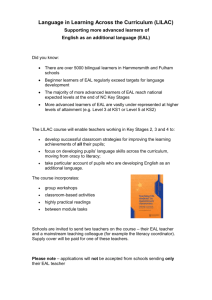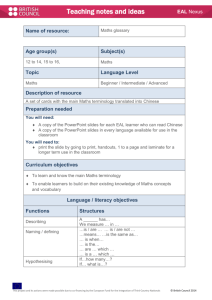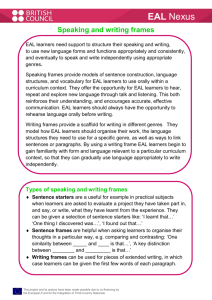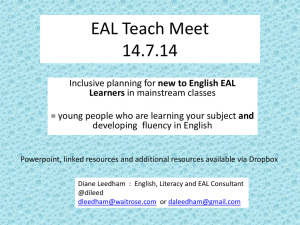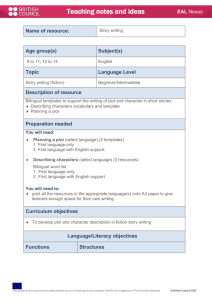Bilingual dictionaries and translation software
advertisement
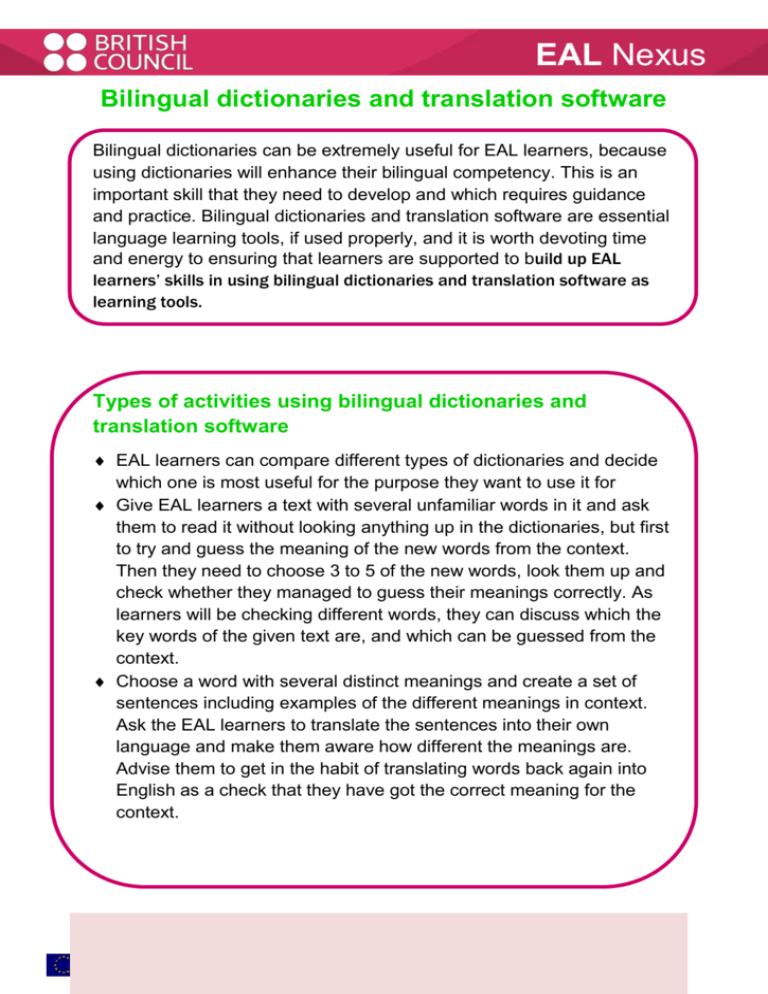
EAL Nexus Bilingual dictionaries and translation software Bilingual dictionaries can be extremely useful for EAL learners, because using dictionaries will enhance their bilingual competency. This is an important skill that they need to develop and which requires guidance and practice. Bilingual dictionaries and translation software are essential language learning tools, if used properly, and it is worth devoting time and energy to ensuring that learners are supported to build up EAL learners’ skills in using bilingual dictionaries and translation software as learning tools. Types of activities using bilingual dictionaries and translation software EAL learners can compare different types of dictionaries and decide which one is most useful for the purpose they want to use it for Give EAL learners a text with several unfamiliar words in it and ask them to read it without looking anything up in the dictionaries, but first to try and guess the meaning of the new words from the context. Then they need to choose 3 to 5 of the new words, look them up and check whether they managed to guess their meanings correctly. As learners will be checking different words, they can discuss which the key words of the given text are, and which can be guessed from the context. Choose a word with several distinct meanings and create a set of sentences including examples of the different meanings in context. Ask the EAL learners to translate the sentences into their own language and make them aware how different the meanings are. Advise them to get in the habit of translating words back again into English as a check that they have got the correct meaning for the context. This project and its actions have been made possible due to co-financing by the European Fund for the Integration of Third-Country Nationals This project and its actions were made possible due to co-financing by the European Fund for the Integration of Third-Country Nationals. EAL Nexus Practical ideas for using bilingual dictionaries and translation software Top tip: The best bilingual dictionaries give examples of the word in context ? To consider: Teach the EAL learners to use bilingual dictionaries and translation software intelligently, to think about the context and whether the translated word or phrase makes sense in that context. Choose a good dictionary and practise using it Help EAL learners to use good bilingual dictionaries appropriate for their level. If possible the dictionary should give examples of the word in context, not just synonyms. Avoid phrase books or mini dictionaries that are intended for tourists as they will not be of any help in the classroom Spend some time introducing paper dictionaries (e.g. glossaries of key words or phrases for a topic) to the EAL learner and teach them how to find out what kind of information is provided. Some publishers have ready-made worksheets, sometimes even online. Teach your EAL learners how to identify which are the crucial words from a phrase or expression to look up in the dictionary. Be aware of ‘false friends’ and misleading cultural connotations. False friends are words which look the same in two languages but have quite different meanings. Misleading cultural connotations are words that exist in two languages, but are used in specific cultural contexts. Using a dictionary without being equipped with the appropriate knowledge and skills, can be very time-consuming – make sure you give EAL learners enough time. Assess EAL learners’ first language proficiency Take into consideration that EAL learners may be more or less proficient in their first language and that their overall literacy experience may vary. This will help you to determine how much guidance they require in order to develop the skill of how to use their dictionary so that it helps them understand and compose English text. This project and its actions have been made possible due to co-financing by the European Fund for the Integration of Third-Country Nationals This project and its actions were made possible due to co-financing by the European Fund for the Integration of Third-Country Nationals. EAL Nexus Teach parts of speech Encourage your EAL learners before looking up words to check which part of speech is needed in a given context. Translate back into English It is usually a good idea to translate back. This means you look up how the word you found is translated into English. Use short, simple sentences When using translation software, make sure that you use short, simple sentences which are as unambiguous as possible. This will help reduce the amount of editing needed to make sense of the translation. Find an image on the internet A good way of checking if you have found the correct translation for all words that can be visualised is to find an image on the internet. Type (or paste) the word you have found into an image finder. If the expected image comes up, you are likely to have found the correct translation. If not, you may have to look for alternative word. Use of bilingual dictionaries in external exams Check the rules for using bilingual dictionaries during external exams, as these vary and are subject to change. Make sure that you have evidence of the EAL learners’ first entry to the UK. Ask EAL learners to write in their first language For EAL learners who are literate in their first language it is a useful strategy to ask them to do any extended pieces of writing in their first language, particularly if no scaffolding such as cloze procedures or writing frames are available. Then you could use translation software to get a rough idea what the learner wants to say, which helps you to model a correct English text. This tends to be much more effective than asking the EAL learner to use translation software to help them to do a piece of extended writing in English. This project and its actions have been made possible due to co-financing by the European Fund for the Integration of Third-Country Nationals This project and its actions were made possible due to co-financing by the European Fund for the Integration of Third-Country Nationals. EAL Nexus Literary texts studied for exams Never attempt to put literary texts into translation software. Authors of literary texts may play with ambiguities and violate the grammatical rules. Machines are not able to cope with this and the translation you get will most likely not be helpful for EAL learners. It is much better to use Wikipedia in other languages to find summaries of literary works or information on specific topics. With a bit of patience you may also find educational websites in the EAL learner’s first language and free downloads of translations of classical texts on the internet. This can be helpful with EAL learners who are highly literate in their first language. Good for EAL, Good for All: Can I use bilingual dictionaries and translation software with the whole class? Encourage all learners to use dictionaries in lessons, that way the EAL learners will feel included in the activities. Bilingual dictionaries and translation software are more commonly used with early stage bilingual learners, but advanced EAL learners can also be encouraged to use them. They can help learners to develop their first language and make links between their languages, and research shows that developing both languages has cognitive benefits. This project and its actions have been made possible due to co-financing by the European Fund for the Integration of Third-Country Nationals This project and its actions were made possible due to co-financing by the European Fund for the Integration of Third-Country Nationals.
